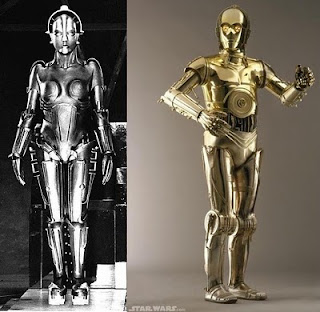THE MEXICO TRILOGY: EL MARIACHI (1992), DESPERADO (1995) & ONCE UPON A TIME IN MEXICO (2003)
Happy Halloween and Happy Birthday to us! This Halloween, Digging Star Wars turns 11! To celebrate, our guest writer John Osif picks not one... not two... but three films to connect with S2E6 of THE MANDALORIAN...
Film Comparison: The Mexico Trilogy
 |
| Photo: John Osif's Great-Grandfather in Ireland circa 1922 |
The Mandalorian – Season Two – Episode Six – “The Tragedy”
This particular episode, amongst an admirable run of excellent episodes this season, is a beautiful mess. A wonderful monster mash of bone crunching combat, gratifying character returns, heartbreaking narrative shifts and jaw dropping logic miscalculations. In other words, the perfect episode to be directed by the one and (truly) only Robert Rodriguez.
The first time I watched this episode I could feel the emotional rug being pulled out from under me repeatedly. From hearing Mando laugh for the first time as Grogu reacts to his name to the surprising destruction of the ever-suffering Razor Crest, I was glued to the screen. Images of delicious grandeur like the perfect reveal shot of Boba Fett in his iconic armor often unfortunately offset (for me) by several WTH moments (how many times does Mando try and run into the Force field only to be thrown aside like a Looney Tune?) and in an effort to get up the hill as fast as possible to save Grogu from the Dark Troopers he simply runs past his jet pack to huff and puff it on foot up the vertical slope? By the way, I am aware that a fitting Jedi name for me would be Nitpick Calmdownson.
The reason I know Mr. Rodriguez was a perfect choice for this episode is his mastery of the action sequence. His Mexico Trilogy is an open love letter to low budgets, realistic fight sequences, creative camera angles, moody lighting and use of natural surroundings. Even if he is directing in the well-funded Star Wars universe, his directing highlights the grit. Check out the similarities of these action sequences from a filmmaker’s perspective. Pay attention to what is predominant in each shot. There is only one person or item in each shot that captures your attention. Clean and clear filmmaking. No dizzying John Wick-style mob scenes and confusing shots. This director is always telling a story even during an action scene:
In all of Rodriguez’s films the camera orients the action. It tells the viewer where to focus when and what to be aware of so the next violent beat has full impact. As a viewer, we get the visceral delight of relishing the choreography and the violence of the action, while also appreciating where it came from and where it’s going. This mode of filmmaking allows us to foresee the action and building suspense, while also allowing us to realize the action and enjoy the payoff. Even if the payoff in these two scenes is heartbreaking. This example from Desperado ends with a “child” being injured and rushed away to an uncertain fate. The scene from The Tragedy ends with “The Child” being lost to Mando.
The beauty Rodriguez brings to both instances is the beauty of imperfection. In the Mandalorian you can see the lens on the corners of the screen in certain shots, causing a vignette effect. Rodriguez doesn’t care. Boba Fett is often filmed with the sun directly behind him, causing his face to be silhouetted to the viewer. Big deal. Pieces of shattered Stormtrooper masks hit the lens upon impact. Filthy and effective. He uses what is available; dust, lens flare, minimal studio lighting, sweat and practical explosions. And it is almost always effective. I was never taken out of the realism by shoddy CGI. In Desperado you can smell the gasoline. In The Tragedy you feel the weight of Boba’s gaffi stick. Beautifully ugly.
As Season Two’s end draws near, I would not be surprised if Din Djarin’s story also reaches its culmination. This episode feels like a warning bell, a call to action. Mando knows he needs an army to end this madness with Moff Gideon and faithfully deliver Grogu “home”. Much like Antonio Banderas’ El Mariachi in Desperado, Din Djarin first appears as a lone figure fighting a lonely battle only for it to be revealed that their colleagues are devoted, close by and willing to join the fight. Mando’s story circle draws near to completion in my view. What is his purpose other than delivering the child and returning to a circular life of catching fugitives? And with so many new story threads introduced and developed this season with all new characters it will be interesting to see what lies ahead for our hero as, like El Mariachi, he walks a dirty and dusty road into the orange sunset.
This entry was written by John Osif.
John Osif is a Father/Filmmaker/Writer who is currently working on writing new songs for his reunited high school band’s second reunion album. Conterpoint’s first reunion album was released in 2018 and is available online anywhere you buy music.
Note from Chris: This isn't the first time El Mariachi (1992) has popped up on Digging Star Wars. It was listed among Mike Zolomij's TOP 10 picks for our 10th Anniversary last Halloween and "My Personal Film Festival During This Time" in Week 04 of the Pandemic Lockdown of 2020.


Comments
Post a Comment